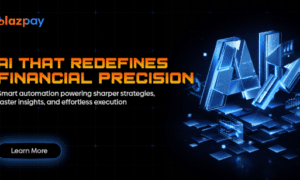In vertical SaaS, the days of separating financial strategy from product execution are fading fast. The rise of agentic AI, autonomous systems capable of making operational decisions without human intervention, is forcing a convergence of disciplines that once operated in silos. Private equity-backed software companies, in particular, now face a reality where the speed and precision of product delivery depend directly on the way capital is allocated.
It is a shift felt most acutely by leaders who have navigated both worlds. Among them is Matthew Ross, the General Manager of Beacon Software and a member of the Forbes Business Council, recognized for uniting corporate strategy, capital markets insight and go-to-market execution. He is known for scaling B2B software and service companies through data-driven growth, operational discipline and strategies that strengthen both product and market position. “When leaders connect the financial architecture of a company with its product ambitions, they create a foundation for sustained innovation,” he says.
This goes beyond tightening budgets. It calls for capital decisions with the same iterative mindset used in sprint planning, allocating resources dynamically to fuel features, platforms and AI capabilities that will define competitiveness. In boardrooms and engineering stand-ups alike, financial fluency and technical fluency are becoming the same language. This is more than just cutting costs. It means making capital decisions in the same way you plan for sprints, by using an ongoing, flexible approach to assign resources. This helps support features, platforms, and AI tools that will shape how competitive a company is. In meetings from boardrooms to daily stand-ups, having a good understanding of finance, with skills like financial modeling and valuation, is now just as important as knowing technical details. These skills help leaders figure out the value of products, projects, and future investments, making sure money is used in line with innovation.
Capital as a Catalyst for Agility
Across the software sector, capital allocation is increasingly being treated as a lever for operational agility. In PE-backed SaaS, refinancing transcends reducing the interest expense as it also requires a strategic enabler of faster product cycles. Analysts are pointing to a trend: companies that directly tie funding to product milestones are delivering new capabilities up to 40% faster than those relying on annual budget cycles.
This principle was on display during an R&D transformation at Kaseya, designed to position the company as a leader in the AI IT management software space. Ross helped develop the strategic and operational plan that connected capital deployment with platform evolution. The initiative was months in the making, with sessions spanning Austin, Miami and Dublin. By the time DattoCon Europe 2025 arrived, the results were visible as Knowlton’s keynote unveiled innovation milestones built on that groundwork.
The takeaway for the industry is clear: capital strategy must be embedded in the product roadmap, not layered on top of it after the fact. In an environment where AI capabilities age in months, funding decisions need to be as agile as the technology they support.
Growth Engines in the Product Age
Even the best-funded product initiatives can stall without a precise go-to-market strategy. In vertical SaaS, where customer bases are specialized and competitive moats depend on domain-specific value, the ability to communicate the product’s advantage is as important as building it. The next generation of enterprise buyers expects functionality and a complementary, clear narrative of how a platform will adapt to their needs over time.
Ross’s work offers a case study in this principle. Deal Bridge Media, a marketing agency specializing in founder-led content strategies for B2B software and services companies, offers an example of how targeted market positioning can translate into sustained demand. Its campaigns for clients such as BoomPop and Codingscape demonstrated that disciplined storytelling, when paired with clear product value, can accelerate adoption and convert technical strengths into measurable commercial impact.
For product leaders in vertical SaaS, the lesson is that growth strategy and product strategy are inseparable. A misaligned launch, or one without a strong narrative, can waste months of engineering output and erode investor confidence. In an AI-native landscape, where adoption curves can spike or flatten in weeks, precision in both messaging and market entry is a competitive weapon.
Operating at the Crossroads of Capital and Code
As agentic AI capabilities mature, leadership in vertical SaaS portfolios is taking on a new shape. It is no longer enough to manage a profit-and-loss statement or oversee product delivery in isolation. The role now demands orchestration, coordinating capital flows, technical execution and operational readiness in a way that keeps all three moving in sync.
In the wider industry, the convergence of financial strategy and product execution is emerging as a defining trait of effective leadership. Ross’s track record, spanning large-scale capital projects and market-facing product initiatives, reflects a leadership approach that bridges strategic finance with technical execution, a combination increasingly sought after in PE-backed SaaS and AI-native enterprises. “When you understand the financial levers as well as the engineering constraints, you can make decisions that accelerate value without sacrificing stability,” he notes. This dual fluency enables leaders to shape strategies that govern how companies fund innovation, coordinate their teams and implement AI-driven systems with precision.
The leaders best equipped for this moment are those with a proven track record of aligning financial precision with technical delivery. The combination builds resilience, enabling organizations to pivot quickly without losing strategic direction.
The Future of Leadership in AI-Native Enterprises
The integration of financial strategy and product execution can hardly be construed as a passing phase. It is the operating model that will define the next decade of enterprise software. Leaders in vertical SaaS, particularly in PE-backed portfolios, will need to think in both forecasts and features, shifting resources with the same precision they expect from their engineering teams.
For Ross, this is less a prediction than a lived reality. “The companies that win in the AI-native era will be the ones that treat capital like code,” he says. “That means constant iteration, real-time feedback loops and the ability to deploy resources exactly where they will accelerate value creation.”
The shift is already underway. Those who adapt will find themselves running organizations that are financially sound, technically advanced and, above all, structurally prepared to compete in a world where capital decisions and code commits carry equal weight.





























